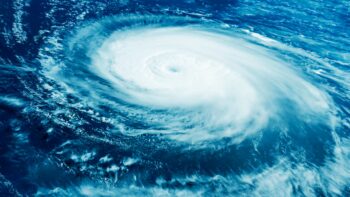
The 2025 Atlantic hurricane season is already shaping up to be a busy one. Experts from the National Oceanic and Atmospheric Administration (NOAA) are forecasting above-average storm activity, with as many as 19 named storms and several likely to reach hurricane or even major hurricane strength. This means coastal communities—and even inland areas—face a heightened risk of wind damage, flooding, and prolonged power outages.
In fact, the season is off to a dramatic start with Hurricane Erin, which has already become a major hurricane in August. While it remained offshore from the U.S., Erin forced evacuations in parts of North Carolina and caused dangerous rip currents as far north as New Jersey and New York. The storm is a reminder that even systems that don’t make landfall can cause significant disruption, and it highlights why early preparation is essential.
The peak months of the season—late August through October—are approaching quickly. Now is the time to make sure your household is ready.
Why Preparation Matters
Every year, families are caught off guard because they wait until a storm is already approaching to gather supplies, review evacuation plans, or check insurance coverage. By then, store shelves are often empty, gas lines are long, and making safe decisions becomes harder.
The good news: taking practical, proactive steps now can dramatically reduce your risks and stress if a hurricane does head your way. Below is a detailed preparation guide covering safety, home protection, finances, and communication.
Build a Robust Emergency Kit
A well-stocked emergency kit should sustain your household for at least five to seven days without outside assistance. Hurricanes can cut off access to stores, shut down electricity, and block roads. Your kit should include:
- Water: One gallon per person per day.
- Nonperishable food: Canned goods, granola bars, peanut butter, and shelf-stable meals.
- Medical supplies: Prescription medications, first aid items, and extra glasses or contact lenses.
- Light and power sources: Flashlights, batteries, candles, and portable power banks.
- Communication tools: A battery-powered or hand-crank radio to get updates if internet and cell service fail.
- Sanitation: Wet wipes, hand sanitizer, garbage bags, and toiletries.
- Comfort items: Books, puzzles, or games for children to help pass the time.
- Pet supplies: Food, medications, and carriers for safe transport.
It’s also smart to keep these items stored in waterproof containers or bags in case of flooding.
Have an Evacuation Plan
Even if you don’t live directly on the coast, hurricanes can cause widespread flooding and wind damage miles inland. Planning ahead means you won’t be scrambling in the middle of an emergency.
- Know your evacuation zone. Local governments publish maps showing which areas will be asked to leave first.
- Map primary and backup routes. Highways may become congested or blocked. Identify alternate paths ahead of time.
- Plan for vehicles. Keep your gas tank at least half full throughout hurricane season. Electric vehicle owners should know where charging stations are located along their route.
- Arrange for special needs. If you or a family member have medical or mobility challenges, register with local emergency services so they know to assist you if evacuations are ordered.
- Designate a contact. Choose a friend or family member outside the storm zone as your check-in person so others know you are safe.
If you wait until officials issue an evacuation order, traffic may already be heavy. Having your plan ready to go saves precious time.
Protect Your Home
Protecting your home before a storm arrives can make a major difference in how much damage you face.
- Trim trees and shrubs. Overhanging branches can easily fall on roofs, cars, or power lines.
- Clear gutters and drains. Blockages increase your risk of flooding.
- Bring in outdoor furniture and equipment. Loose objects can become dangerous projectiles in high winds.
- Board up or shutter windows. Glass is vulnerable to flying debris.
- Inspect your roof. Loose shingles, tiles, or flashing should be repaired. If possible, consider upgrading to storm-rated materials.
- Document your belongings. Take photos or videos of valuable items and store them in the cloud. This speeds up insurance claims if damage occurs.
- Store important documents safely. Birth certificates, insurance policies, and financial records should be kept in waterproof containers or scanned digitally.
These steps not only reduce risks but can also help you recover more quickly after a storm.
Create a Financial Survival Kit
Hurricanes don’t just threaten safety—they can upend your finances. Advance preparation can help you avoid costly setbacks.
- Review insurance coverage. Standard homeowners’ insurance usually excludes flood damage. A separate flood insurance policy may be necessary, even if you don’t live in a designated flood zone.
- Understand your deductibles. Hurricane deductibles are often higher than standard ones. Make sure you know what you’d be responsible for paying.
- Maintain an inventory. Write down details of appliances, furniture, and electronics. Include serial numbers, receipts, and photos.
- Keep cash on hand. ATMs and card readers may be unavailable during extended power outages.
- Know your aid resources. Familiarize yourself with assistance options from FEMA, the Red Cross, and local relief groups.
Preparing financially ensures you won’t be caught off guard when it’s time to rebuild or replace essentials.
Stay Informed and Connected
Hurricanes can form and intensify quickly, leaving little time to react. Staying informed is just as important as having supplies.
- Download official apps. The FEMA app and local emergency management apps provide real-time alerts.
- Enable Wireless Emergency Alerts on your phone. These short messages can warn you of urgent threats.
- Use a NOAA weather radio. This ensures you’ll get information even if the internet and cell networks fail.
- Follow local authorities. County and city officials provide guidance tailored to your area.
- Check forecasts often. Even if a storm is days away, paths can shift dramatically.
Preparedness isn’t just about supplies—it’s about making decisions early, based on reliable information.
The Bottom Line
With forecasts pointing to an active hurricane season and storms already forming early, preparation is more important than ever. Hurricanes don’t just affect coastlines—they can impact millions of people hundreds of miles inland.
Taking the time now to build a kit, make a plan, and secure your home can save lives, minimize damage, and give you peace of mind as the season intensifies. The peak is fast approaching—don’t wait until the next storm is on the radar to take action.



